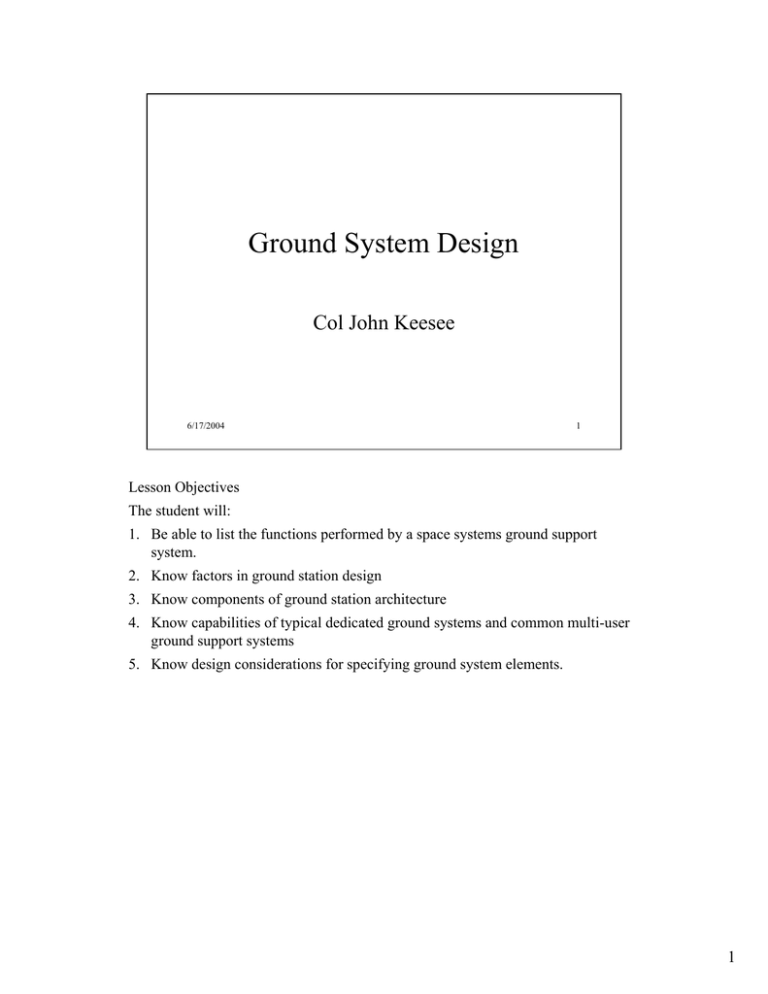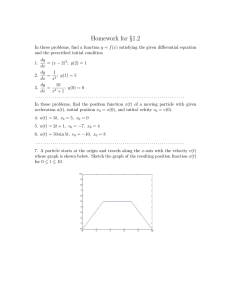Ground System Design Col John Keesee
advertisement

Ground System Design Col John Keesee 6/17/2004 1 Lesson Objectives The student will: 1. Be able to list the functions performed by a space systems ground support system. 2. Know factors in ground station design 3. Know components of ground station architecture 4. Know capabilities of typical dedicated ground systems and common multi-user ground support systems 5. Know design considerations for specifying ground system elements. 1 Overview • Ground Systems – Support the space segment • • • • Command and Control Monitor spacecraft health Track Calculate spacecraft attitude – Relay mission data to the users 6/17/2004 2 Ground systems have a command (uplink) function as well as a data (telemetry and mission data) function. 2 Ground Station Design • Location, location, location – Coverage – Data-user needs – Cost – Accessibility – Availability • Link data rates – G/Ts, EIRP • Requirements for data handling • Communication between ground system elements and data users 6/17/2004 3 These are the important factors in ground station design. The spacecraft orbit and mission characteristics will drive available locations for ground systems. Satellite transmitter characteristics and data rates will determine the ground system’s transmitter and receiver operating characteristics. Because the facilities that process data may not be co-located with the receiving system, the ground system will have its own terrestrial and space communication links. 3 Ground System Elements • Mission elements and facility elements • Ground station is where the Earth-based end of satellite communication takes place – Antenna system – Receive RF equipment – Transmit RF equipment – Mission data recovery – Data-user interface – TT&C equipment – Station control center – System clock 6/17/2004 4 The ground system consists of both mission (functional) elements and facilities. A ground station would usually consist of most of these elements 4 Control Centers • Spacecraft Operations Control Centers – Monitors and commands the spacecraft bus – Analyzes spacecraft telemetry – Coordinates and controls Payload Control Center access – Includes data monitoring equipment, commanding facilities and communications 6/17/2004 5 In most cases, the spacecraft operations control center controls the overall mission, even though the payload is the reason for the mission. The SOCC monitors the health and status of the bus and, in some architectures, the payload as well. Sometimes it’s a multi-mission facility, and many times is separated physically from the payload operations control center. 5 Control Centers continued • Payload Operations Control Center – Analyzes telemetry and mission data from instruments – Issues commands to instruments • Mission Control Center – Plans and operates the space mission • SOCC, POCC and MCC may not be co-located • May require hot spares to maintain high availability • Survivability may dictate multiple ground system sites for coverage and redundancy 6/17/2004 6 The entire focus of the POCC is the payload, its monitoring, management and control. The mission control center would be responsible for the entire constellation of satellites. The SOCC, the POCC and the MCC are many times not co-located. When the availability requirement is very high we may specify multiple systems running in parallel (hot spares) to minimize the downtime in case of a failure. 6 Communication Links • Communication support required between ground system elements and data-users – Landline and satellite connections – International links through comsats and terminal equipment • Intelsat, Telstar, Westar, DSCS, Milstar – Internet protocols 6/17/2004 7 The communication links between the SOCC, the POCC and the MCC might be through landlines, satellite connections, or the internet. Typically military systems may use the Defense Satellite Communication System to relay information between nodes. 7 Data Handling • • • • • • • Multiplex—Demultiplex Encryption—Decryption Encoding—Decoding Data Compression Time Tagging Data storage Data quality monitoring 6/17/2004 8 Data from the satellite are usually multi-plexed (usually Time division multiple access) to allow communication with multiple satellites over the same link. We discussed these functions in the lesson on TT&C 8 Defense Meteorology Satellite Program • Spacecraft uplink – L-band (1.75 to 1.85 GHz) 2 kbps (command) • Downlink – S-band (2.2 to 2.3 GHz) 1024 kbps (mission data) • Command Readout stations and AFSCN • Mission data transfer from ground stations to DMSP central facilities via domestic satellite and landlines • Similar connections to large data processing centers • Some data-users receive direct from the spacecraft 6/17/2004 9 9 Alternatives to Dedicated Ground Systems • Host systems provide some or all parts of the ground system – Saves money, has high reliability and availability – However, may not be optimum for a specific mission • Sharing resources requires scheduling coordination and prioritization – May impact user mission 6/17/2004 10 10 Air Force Satellite Control Network • Eight ground stations (RTS) with two antennas each • Two central locations – Consolidated Space Test Center at Sunnyvale CA – Consolidated Space Operations Center at Schriever AFB CO • Combined SOCC, POCC, and MCC at either CSTC or CSOC • Communication links via landline and comsats – DSCS and Intelsat 6/17/2004 11 11 AFSCN continued • 18m and 14m antennas for TT&C and mission data • Space Ground Link System (SGLS) – Twenty channel pairs (one uplink, two downlink carriers) – 1.024 Mbps downlink at 2.2—2.3 GHz – 2 kbps uplink at 1.75—1.85 GHz – Provides range, range rate, telemetry and mission data • Non-SGLS downlinks provide up to 5 Mbps 6/17/2004 12 12 NASA Tracking and Data Relay Satellite System • Three geo-synchronous relay satellites – Supports 20 sub-synchronous satellites multiple-access S-band links • 2.1064 GHz forward or command link (uplink) • 2.2875 GHz return or downlink – Two each single-access links at S-band and Ku-band • 2.025—2.120 GHz forward link (S-band) • 2.200—2.300 GHz for the return path • 13.775 GHz forward and 15.003 GHz return (Ku-band) 6/17/2004 13 13 TDRSS continued • Ground station at White Sands NM • Satellites act as “bent pipe” to all traffic • G/Ts and EIRP specified in SMAD Fig 15-9 and 15-10 • Command data and telemetry through NASA’s NASCOM communication network • Combination ground system centers provided at Goddard (Greenbelt MD) and Johnson Space Centers (Houston TX) 6/17/2004 14 14 TDRSS Overview 6/17/2004 15 15 TDRSS Spacecraft 6/17/2004 16 16 TDRSS Antennas 6/17/2004 17 17 TDRSS Constellation 6/17/2004 18 18 TDRS H, I, J 6/17/2004 19 Image taken from NASA's website. http://www.nasa.gov. Used with permission. 19 TDRSS Ground Antennas 6/17/2004 20 20 TDRSS Ground Antennas 6/17/2004 21 21 Commercial Ground Systems • Typically S-band and X-band downlink and Sband uplink • Downlink data rates to 15 Mbps (S-band) and to 150 Mbps (X-band) • Uplink data rates to 1.5 Mbps • Time division multiplexed (TDM) and Consultative Committee for Space Data Systems (CCSDS) telemetry formats • User communication uses IP and dialup or dedicated lines 6/17/2004 22 22 Commercial Ground Systems continued • Commercial Ground Network (Universal Spacenet) – Ground stations in Alaska and Hawaii • Ground Network System (Allied Signal Technical Service Corporation – Ground stations in Greenland, Alaska and Norway 6/17/2004 23 23 Design Considerations • Required satellite coverage determines the number and location of ground stations – LEOs are particularly demanding because of short and infrequent contact opportunities – Large quantities of mission data must be stored on board and downlinked in short periods – Infrequent TT&C contact demands more onboard autonomy 6/17/2004 24 24 Design Considerations continued • Data user distribution drives processing and communication requirements 6/17/2004 25 25 References • Wertz, James R. and Wiley J. Larson, Space Mission Analysis and Design, Third ed., Microcosm Press, Torrance CA, 1999 • http://www.losangeles.af.mil/SMC/PA/Fact _Sheets/cw_fs.htm • http://spacelink.nasa.gov/Instructional.Mate rials/Curriculum.Support/Space.Science/Sat ellite 6/17/2004 26 26



